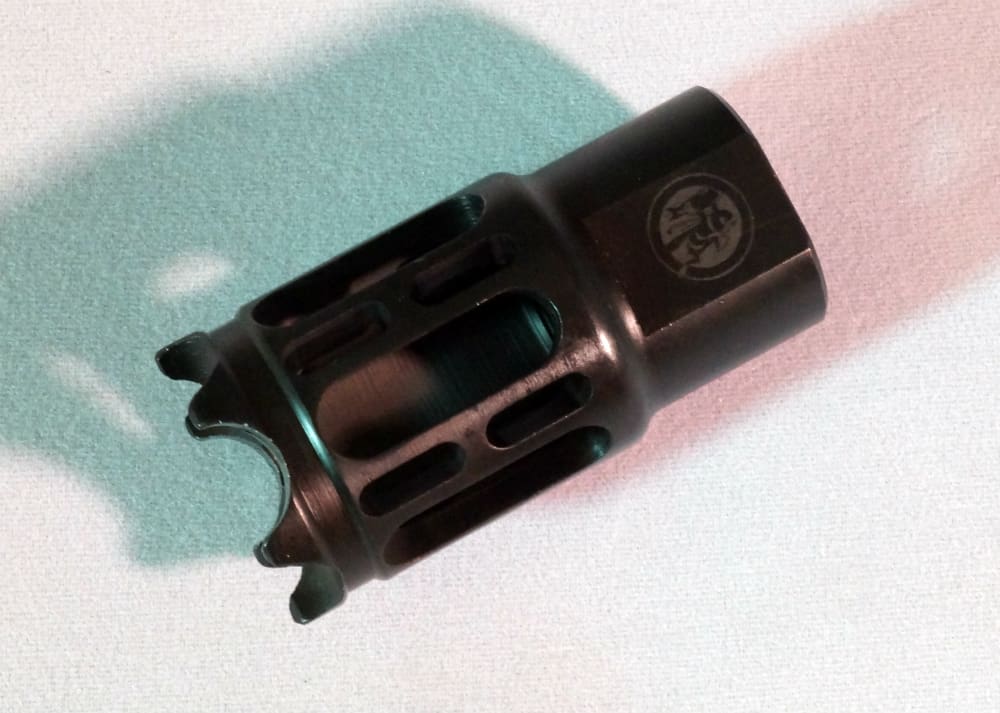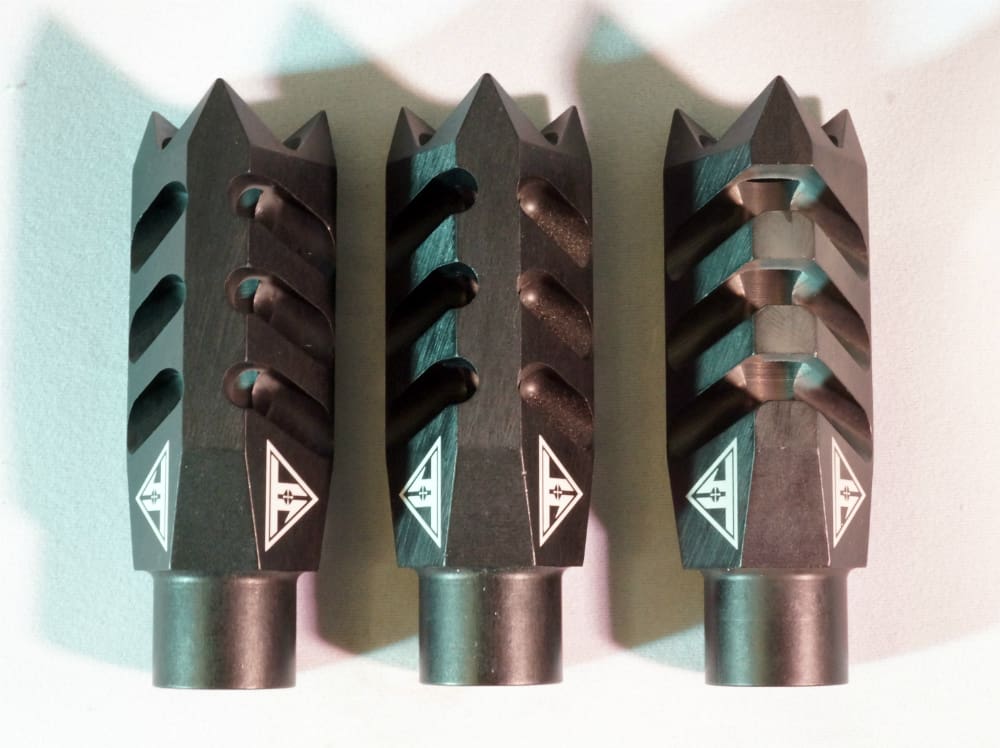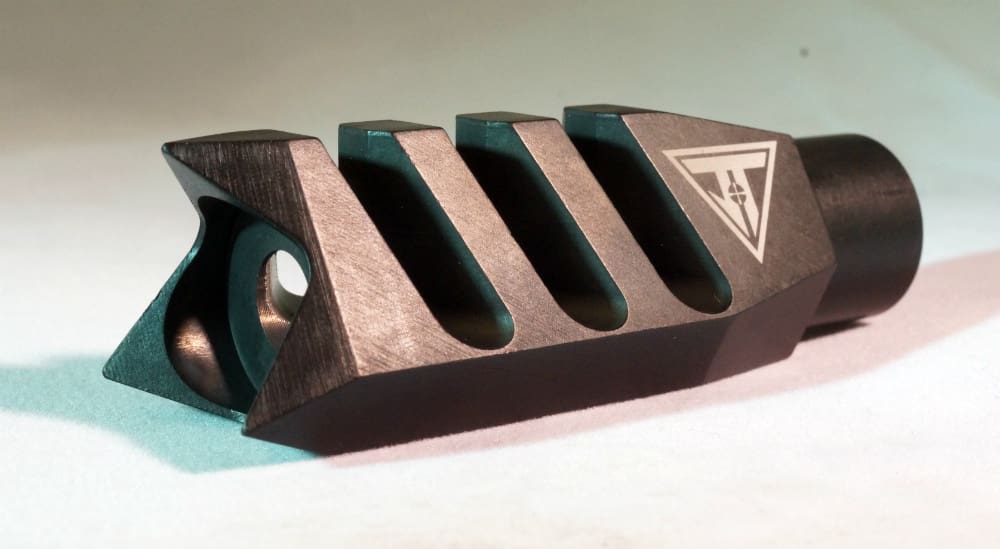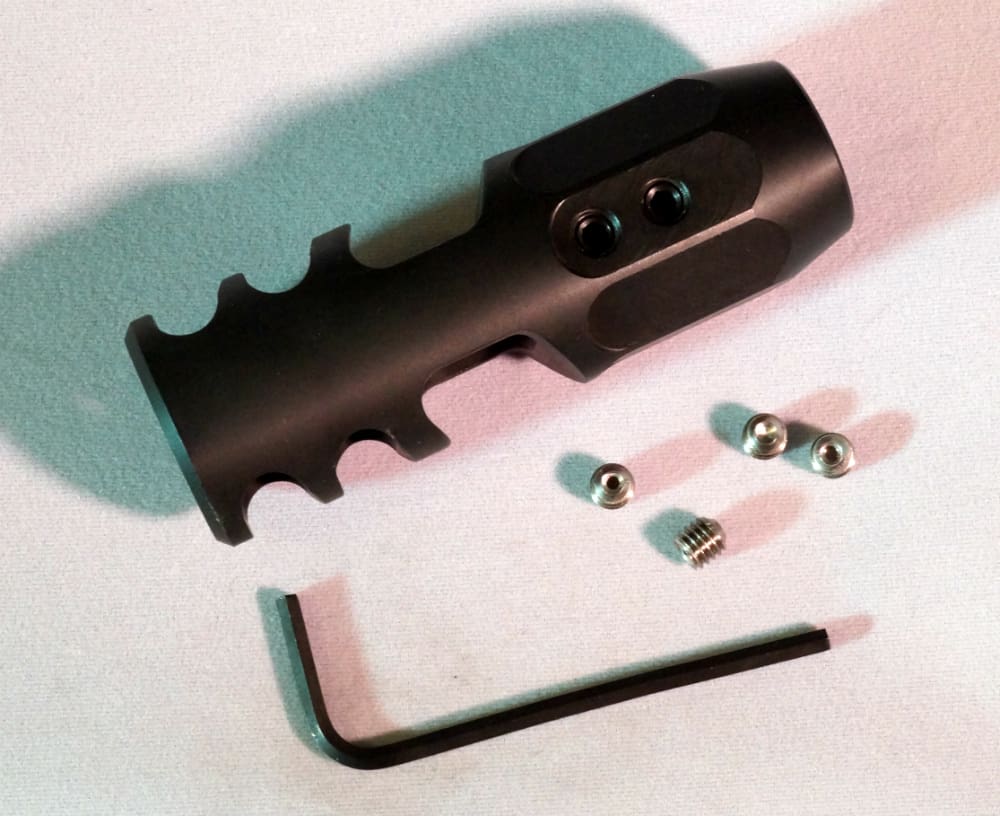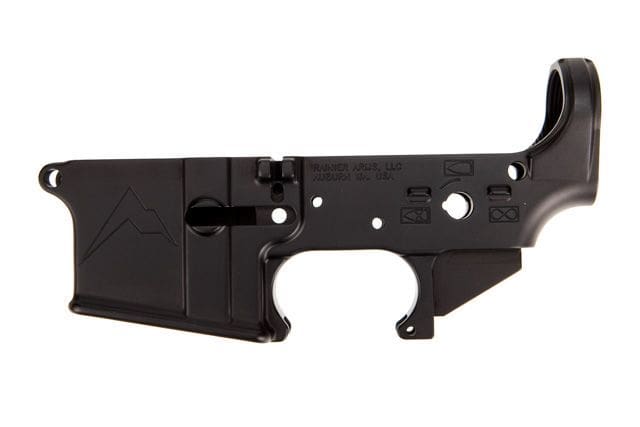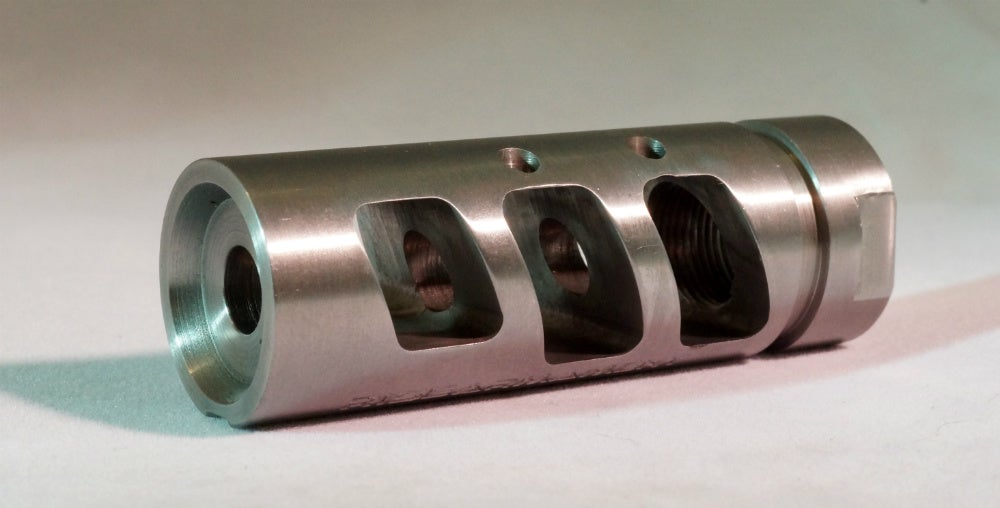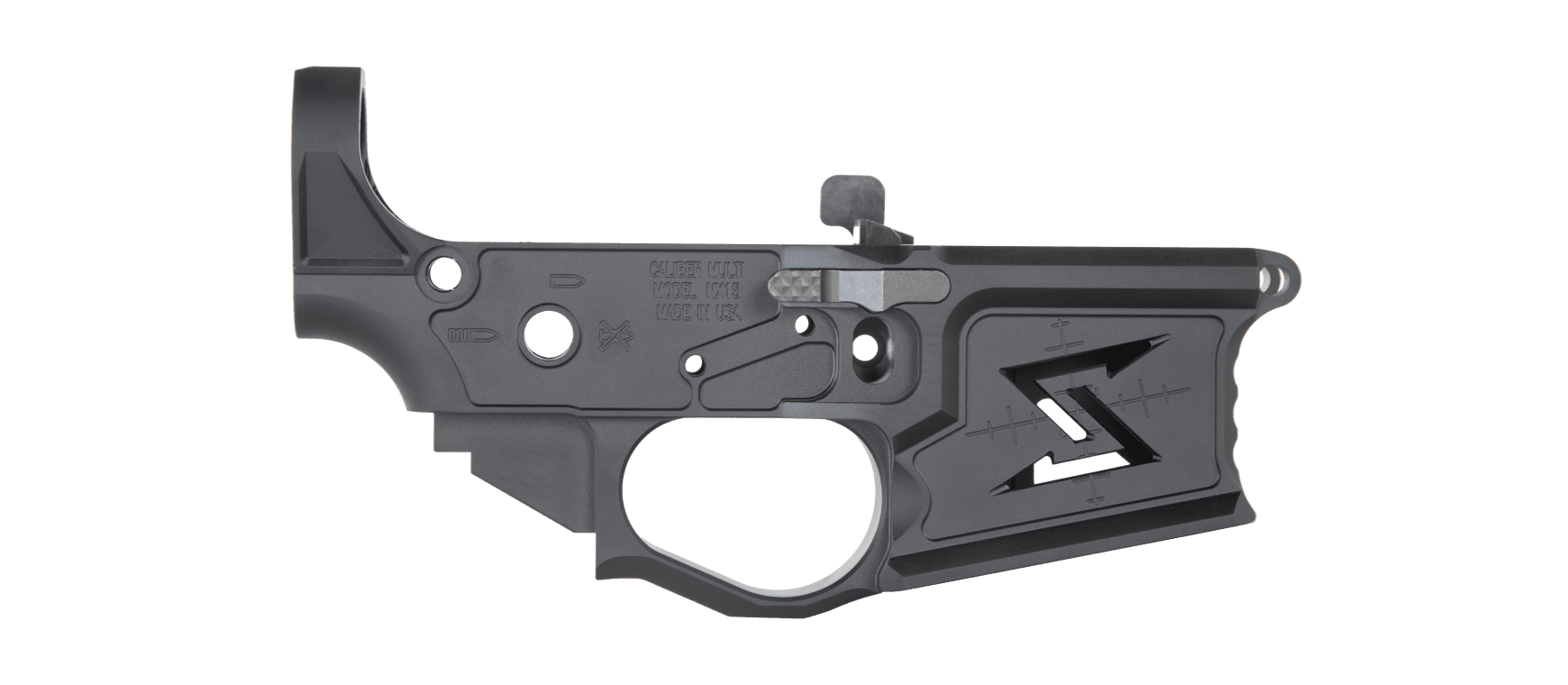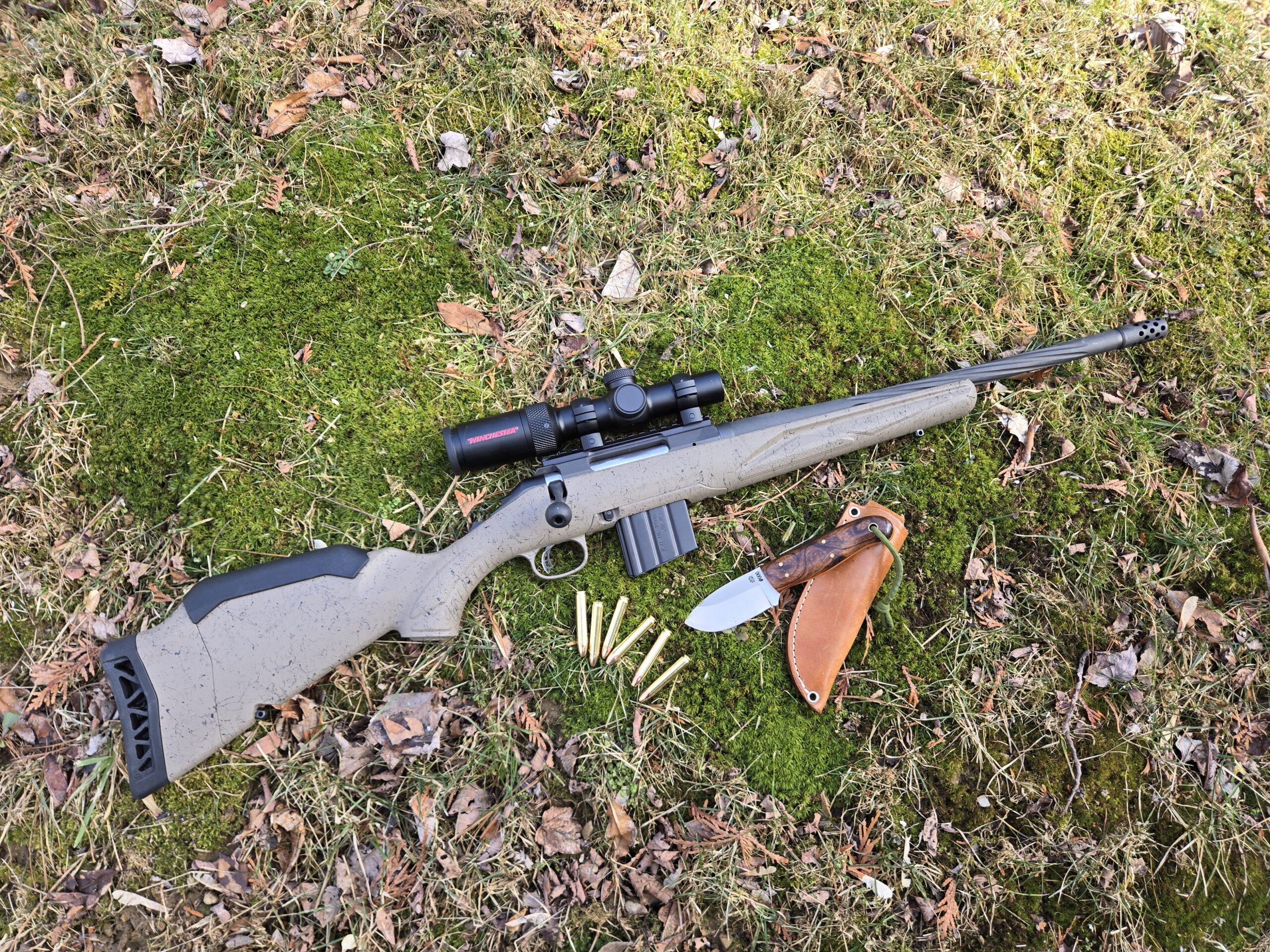In the past, we compared 35 different AR-15 muzzle devices. That shootout, like this one, pitted them against each other in a sled test to see which reduced rearwards recoil energy the most. However, this time around there are [almost] no flash hiders, linear compensators, or other devices not actually designed to reduce recoil. A total of 37 brakes and compensators joined in the fun for roundup part deux, although 8 of them are carry-overs from the first test, including the previous recoil eliminating winner. . .
Again though, recoil reduction is only one of many variables worth considering — and how they’re each weighted is a matter of personal opinion and/or intended use — when choosing which muzzle device will adorn one’s rifle. In addition to the objective recoil test, all brakes are listed alphabetically below and I have stated my frank opinion on machining, fit/finish, and utility plus included any items of note as well as the relevant stats for each. Hopefully both muzzle device shootout installments will help narrow down the shopping list.
Additionally, a flash hider-specific test is coming in a few weeks!
EDIT: This is the second test I did, but it hasn’t been the last. The first 5.56 muzzle brake test is HERE, the third is HERE, the first 5.56 flash hiding test HERE, the second 5.56 flash hiding test HERE, and the first .308 brake test HERE. You may also be interested in the AR-15 Drop-In Trigger Roundup HERE.
These tests are expensive, but I’d love to do more. I’ve purchased air pressure sensors designed to log blast waves so we can compare the amount of concussion each muzzle device generates, and these will be used in test four. But I have a lot of brakes to round up for that and the funding is low. I also want to do another AR-15 trigger roundup (component triggers this time) and a couple of flashlight roundups (tactical and gun-mounted). Please consider supporting this sort of testing via my Patreon page. As a Patron you can also get free stuff, join live streams, gain early access, and more.
Recoil Testing
For many brakes and comps, felt recoil reduction is only one goal, with the other primary design intention being the reduction of muzzle movement in any other direction. A steady muzzle means steady sights, and steady sights means fast, accurate shooting. Usually the boogeyman is “muzzle rise” (which I believe is usually just the natural byproduct of rearwards recoil energy anyway). The slow-mo footage for each device in the following video does show some noticeable differences in up/down muzzle movement as well as in flash, but this test was specifically designed only for measuring recoil — rearward energy.
Keep in mind that we’re also talking about the fairly minor recoil of .223/5.56 here, and many prospective purchasers will put recoil reduction at the bottom of their list behind other considerations like aesthetics, price, flash, concussion, etc.
http://youtu.be/zQdUQSHcxLk
With my gas piston AR-15 strapped in a rest and the gas block turned to “off,” which means the action remains locked shut and 100% of the gas goes out the muzzle, I proceeded to “sled test” all of the brakes/comps plus controls of bare muzzle and standard A2 birdcage. The results were highly repeatable and consistent. In fact, the average of the extreme spreads — difference between shortest and farthest result — for everything in the test was only 0.1470 inches. Eight brakes did multiple shots with the exact same result each time.
For the record, I measured in 1/16-inch increments and chose not to round when converting that to decimal measurements later. Averages of multiple measurements were, however, rounded to 4 decimal places and recoil reduction percentages were rounded to 2 places.
With all of that said, our recoil reduction winner is…drum roll please…
Precision Armament’s M4-72 Severe-Duty Compensator!
Yes, you read that right, folks. The winner from shootout #1 is now reigning champion. King of the hill. Dominating the field once again, really, winning by a pretty decent and entirely repeatable margin. With the M4-72 on the muzzle, the test rig slid back an average of 2.3438 inches. With nothing on the muzzle, it slid back an average of 8.8438 inches. That’s a recoil reduction of 73.50% (in shootout #1, it came out to 73.84% so we’re pretty darn consistent here!).
Congrats to Precision Armament for hanging onto the crown, and for coming up with such an incredibly effective brake in such a small, lightweight package!
Recoil test results for all of the entrants can be seen in the graphs and tables below. New for Muzzle Brake Shootout #2 is a performance (percentage reduction in recoil) per dollar graph! I’ve also included a performance per dollar graph based on the first Muzzle Brake Shootout so these figures can be compared across both tests. Click on any of the images below — and on any of the thumbnail-sized photos of the brakes to follow! — to see them full-size. Additionally, the raw data seen in the table can be downloaded as an Excel doc by clicking here.
Muzzle devices that had zero design consideration for recoil reduction (flash hiders, linear comps, etc) were removed from this performance per dollar chart for Shootout #1:
Just the good stuff, hopefully large enough to read it without having to click to enlarge (in case of mobile browsing, etc):
And one table with all of the data:
Some thoughts on test #1 vs. test #2, plus a single chart compiling all of the muzzle devices from both tests ranked by recoil reduction percentage can be found at the very bottom of this article. For now, onto the comparison of each entrant that joined us for Shootout #2!
Muzzle Brakes / Compensators
Listed alphabetically. All stated weights and dimensions are as measured by me. I noted obvious errors on many manufacturers’ sites so chose not to use any of their info across the board.
2A Armament T3 Compensator:
Flawless machining and an extremely consistent and nice black phosphate finish. The complex appearance of the baffle and port structure is really cool. It’s a dual baffle comp that vents more gas upwards than downwards to compensate for recoil-induced muzzle rise. 2A claims it keeps flash to a minimum compared to most brakes and comps. It’s small, light, and works as a QD mount for some suppressors. Also available in titanium.
Click here to jump to its point in the video.
Material: 4140 bar stock steel
Finish: black phosphate
Length: 2.12″
Diameter (at largest point): 0.86″
Weight: 2.56 oz
MSRP: $75
Ares Armor Ares Breath Muzzle Brake:
Easily the largest 5.56 muzzle brake I’ve ever seen, the Ares Breath is over 6″ long, 1.9″ wide, and sports four blast chambers. It’s a cast piece so it has a rough, matte feel and appearance but it’s decently clean with no obvious flaws. The threads are nicely cleaned up after casting and the bore is certainly concentric enough to avoid any hint of baffle strikes. Pinned on permanently, the Ares Breath will bring a 10.5″ barrel up to legal 16″ rifle length. It was not as loud or as fiery as I expected, but even sitting still its looks are loud enough.
Click here to jump to its point in the video.
Material: hardened steel
Finish: black nitride
Length: 6.38″
Diameter (at largest point): 1.9″
Weight: 25 oz
MSRP: $150
Bird Of Prey USA Bird of Prey Compensator:
Right after the Ares Breath alphabetically is another brake that’s a big deviation from the norm. The Bird of Prey is made from a series of triangular, steel plates (“wafers”) bolted together at the corners. The number of openings varies — 5 on the right and left, although in different order, and 3 on the bottom — to compensate for muzzle rise and movement. Gotta love the BoP’s over-the-top, action movie-like promo video.
If you like or at least don’t mind the aesthetics, it does actually seem to make for a decent compensator. Not particularly impressive on straight recoil reduction, placing near the bottom of this pack of brakes and comps, but the balance of gas going up vs. going down seems about right, and it isn’t overly obnoxious to be around (below average for concussion). The machining and the finish are clean and the steel has a quality feel.
Click here to jump to its point in the video.
Material: case hardened steel
Finish: black oxide
Length: 1.86″
Diameter (at largest point): 1.36″
Weight: 5.25 oz
MSRP: $124.95
CMMG Compensator, SV Brake:
There’s basically no information on CMMG’s website about its SV Brakes beyond “very effective muzzle brake, threaded 1/2-28.” Looking at data from this and the last test, its recoil reduction performance was on par with most single chamber brakes. Two ports inside the blast chamber direct gas upwards to combat muzzle rise. I don’t know what kind of steel it’s machined from, but the machining is good and it looks and feels quite nice. The finish is even and deep — I’d guess nitrided.
Click here to jump to its point in the video.
Material: steel of some sort
Finish: guessing nitride
Length: 2.125″
Diameter (at largest point): 0.87″
Weight: 2.73 oz
MSRP: $64.95
DoubleStar BULLSEYE Muzzle Brake:
The BULLSEYE is available in 0.7″, 0.75″, 0.925″, and 1.0″ base diameters to best match your barrel. This 3-chambered brake uses “V” shaped baffles to direct gas and pressure slightly rearward, which is certainly a method employed by the M4-72 to be so darn effective and it works here as well. A strong, runner-up showing for the DoubleStar! The chambers are offset a bit higher than the center of the bore, which makes the top slightly narrower than the bottom to vent more gas upwards, compensating muzzle rise to an appropriate degree. The divot on either side in the wrench flats is a pilot hole, allowing the end user to drill it through and vent gas to the left or the right to combat lateral muzzle movement (e.g., a right-handed shooter generally sees the muzzle move to the right while firing).
Machining and finish are spot on. In a sea of muzzle devices with recessed crowns, I like the domed one on the BULLSEYE if for no other reason than it’s unique.
Click here to jump to its point in the video.
Material: steel of some sort
Finish: guessing nitride. Most of DoubleStar’s muzzle devices appear parkerized, but not this one.
Length: 2.90″
Diameter (at largest point): 1.00″
Weight: 4.88 oz
MSRP: $179.99
Houlding Precision Firearms HPF-15 Curse Muzzle Brake:
Designed to be a good all-around brake and comp, the Curse is a dual-chamber brake with a bunch of relatively small slots instead of full-on, open ports. This keeps blast and concussion to a minimum, while reducing recoil, keeping the muzzle stable, and somewhat reducing flash signature as well. Machining shows a couple of nicks and slightly rough edges. Finish is an even, matte black.
Click here to jump to its point in the video.
Material: 1144 stressproof steel
Finish: melonite
Length: 2.95″
Diameter (at largest point): 0.975″
Weight: 4.75 oz
MSRP: $125
Houlding Precision Firearms HPF-15 Irish Curse Muzzle Brake:
The Irish Curse is a single-chamber version of the Curse, with an extra port on top to compensate for its smaller size. It is one of the most effective single-chamber brakes I’ve tested on the recoil sled. No machining flaws, but it isn’t as clean as some others with just a bit of roughness on edges and such.
Click here to jump to its point in the video.
Material: 1144 stressproof steel
Finish: melonite
Length: 1.95″
Diameter (at largest point): 0.975″
Weight: 2.63 oz
MSRP: $100
JP Compensators Bennie Cooley Standard-Profile:
Available in a bunch of sizes to match your caliber and barrel diameter, plus in matte black or polished stainless finish to match your aesthetic preference. The machining is gorgeous. It’s a shiny, sexy beast. It’s also an effective brake and comp — placing sixth for recoil reduction — and, in standard-profile size, is legal for competition use in the shooting sports that limit such things.
Click here to jump to its point in the video.
Material: stainless steel
Finish: polished (also available in matte black)
Length: 2.31″
Diameter (at largest point): 1.00″
Weight: 3.60 oz
MSRP: $89.95
Juggernaut Tactical JuggerBrake:
The JuggerBrake is an aggressive, modern-looking brake that’s available in 3 flavors: Long Range/Sniper, CQB Right Hand, and CQB Left Hand. While the machining and finish are really great, I can’t really advise anybody to consider purchasing this brake under any circumstance other than as a display item. It was bad enough to deserve an article of its own, so give that a look to learn of the JuggerBrake’s multiple, fatal flaws.
While the CQB brake does not overcompensate for muzzle rise, it’s still made of aluminum and I just can’t get behind that for the reasons shown in the separate review. The Right Hand version I tested on the sled certainly does compensate for a right-handed shooter’s tendency to push the muzzle to the right a little — it can clearly be seen pushing the muzzle to the left in the slow-mo.
Click here to jump to its point in the video. The slow-mo footage on this one is definitely worth watching.
Material: it’s freakin’ aluminum
Finish: anodized
Length: 3.10″
Diameter (at largest point): 1.11″
Weight: 1.97 oz (Long Range model)
MSRP: $99
Lancer Nitrous Compensator:
Lancer’s Nitrous comp is a 3-port brake with an enclosed blast chamber just after the threads. On the top of that blast chamber there’s a pair of holes, designed to vent gas upwards to combat muzzle rise. What makes the Nitrous unique, though, is that these holes are threaded, and the comp ships with 6 set screw “jets” allowing the end user to custom-tune downward force. Choose from any combination of no jets, two large aperture jets, two small aperture jets, and two solid plugs to get it just right.
Machining is top notch. Finish is flawless. I had very high hopes for this brake, as the first port is quite large and that first baffle is angled rearwards a bit like the M4-72’s baffles. I thought it might be the one to unseat the champ. Alas, it came in sixth, just a hair behind the JP.
Click here to jump to its point in the video.
Material: steel
Finish: black nitride or bead blasted stainless steel
Length:
Diameter (at largest point):
Weight:
MSRP: $89.99
Lantac Dragon:
Lantac’s Dragon muzzle brake (DGN556B) was the single most-requested brake for Muzzle Brake Shootout #2. It’s insanely popular and a lot of folks seemed positive it would win. Tied for 12th ain’t bad — tied, actually, with the POF P415 brake that’s damn similar — but it ain’t a win. Were the baffles larger in size and/or if the first two had smaller bore holes through them (for whatever reason, they appear bored for ~.30 cal whereas the muzzle hole is a more typical .223 size), I’d bet dollars to donuts it would jump up a few places. Again, of course, that’s only on straight recoil reduction.
The Dragon is sleek and somewhat understated and performs very well without excessive concussion, plus the ports on top mitigate muzzle rise. Machining is great. The unique, bead blasted-like texture of the nitride finish is pretty cool. I like the feel of it, and it looks good although it does show some superficial scuffing and such.
Click here to jump to its point in the video.
Material: hardened milspec steel
Finish: nitride
Length: 2.57″
Diameter (at largest point): 0.863″
Weight: 3.15 oz
MSRP: $140
Manticore Arms NightBrake:
Manticore’s NightBrake is designed primarily to keep the muzzle nice and steady without increasing flash or concussion, and it seems to do a solid job at this — well, except for bare muzzle-like fireballs out the front — in a compact, lightweight, and aesthetically-pleasing package. The two “strips” of ports on the bottom are solid to keep you dust-free when shooting prone and to allow the open ports on top to compensate for muzzle rise. Machining and finish are both fine, but not exemplary. It looks like QD mounts that work on an A2 birdcage would work on the NightBrake.
Click here to jump to its point in the video.
Material: 8620 steel
Finish: deep black oxide
Length: 1.88″
Diameter (at largest point): 0.86″
Weight: 2.1 oz
MSRP: $57.95
Patriot Ordnance Factory (POF) Muzzle Brake (P415):
As mentioned above, POF’s P415 and Lantac’s Dragon are fairly similar. Similar in dimensions, appearance, chamber and baffle design, and on my recoil sled rig they’re identical in recoil reduction performance. They’re both nitrided, but POF went for a deep black mid-gloss (which appears perfectly done) and Lantac a lighter-toned, satin finish. Machining on the POF is exemplary. It comes with a lock nut to make timing it particularly simple, and at $58 MSRP it’s one of the lower-priced options in this roundup.
Click here to jump to its point in the video.
Material: steel
Finish: nitride
Length: 2.2″
Diameter (at largest point): 0.86″
Weight: 2.9 oz
MSRP: $57.99
Precision Armament AFAB-Mini:
After playing with it for the first Muzzle Device Shootout, I decided the AFAB-Mini would likely be my choice for permanently pinning on a barrel. The machining and finish are flawless, and it has decent recoil reduction performance, excellent muzzle control performance, and appeared to be a really good flash hider as well. Plus, I think it looks cool. Well, after more R&D and time on its CFD program, Precision Armament has deprecated the AFAB-Mini and has replaced it with the AFAB-556 seen below. The new version is supposed to be better in every single way.
Click here to jump to its point in the video.
Material: HTSR 416 stainless steel
Finish: Ionbond CrCN
Length: 2.225″
Diameter (at largest point): 0.865″
Weight: 3 oz
MSRP: no longer available (was $109.95)
Precision Armament AFAB-556:
The new AFAB — that’s Advanced Flash Arresting Brake — takes the old design to a slightly more extreme level, with deeper grooves and a baffle pattern inside the bore. It kind of reminds me of a Graboid (not an insult). It’s supposed to outperform the old one in flash hiding, recoil reduction, and compensation performance. On my recoil sled it actually came in a couple percentage points behind the original AFAB, which really isn’t something the ol’ shoulder dyno can differentiate. Precision Armament suggested that a “break-in” of 10-12 rounds will often bump the performance just a bit, so I may revisit this in the future.
Again, machining is as good as it gets, and the Ionbond finish is very nice.
Click here to jump to its point in the video.
Material: HTSR 416 stainless steel
Finish: Ionbond CrCN
Length: 2.23″
Diameter (at largest point): 0.866″
Weight: 3 oz
MSRP: $109.95
Precision Armament EFAB:
PA’s EFAB, or Enhanced Flash Arresting Brake, is supposed to be the absolute pinnacle of flash hiding compensator design. Each port has a round hole in the middle that diverges outwards into the “Y” shapes visible on the outside. Looking down the bore, the appearance is that of 9 circular blast baffles. It’s certainly a joy to shoot a rifle with either of the AFABs or this EFAB on it — low concussion and blast, stable muzzle — and we’ll see how they fare on camera in the dark for the flash hider testing.
Again, machining and finish are absolutely flawless. Although the EFAB is supposed to outperform the AFAB in every way, I still kind of lean towards the AFAB for my personal rifle because I like the looks a bit more and it’s $50 less expensive (the EFAB ties up a CNC machine for quite a bit more time).
Click here to jump to its point in the video.
Material: HTSR 416 stainless steel
Finish: Ionbond CrCN
Length: 2.43″
Diameter (at largest point): 0.9″
Weight: 3.51 oz
MSRP: $159.95
Precision Armament M4-72:
It won again! Incredible performance in a small, lightweight package. I’ve put hundreds of rounds through this brake now as it has spent some time on my Tavor and AR-15, and it’s really fun to shoot with it on since the gun barely moves at all. Whether that’s up, down, right, left, or back, it keeps the muzzle practically fixed in space. The rearwards-angled baffles do direct some blast rearwards instead of straight out to the sides, but that isn’t really noticeable from behind the gun. Next to the shooter? Sure. It’s not actually uncomfortable concussion that many or most brakes produce, though, it’s more of a blast of fast, hot air and maybe some carbon particles and such.
This thing is pretty dang solid and I hope to see Precision Armament releasing versions of it for more powerful calibers where it will be appreciated even more. Plus, at $89.99, it’s beating out most of its high-quality competition on price as well, and by a big margin in many cases.
Click here to jump to its point in the video.
Material: HTSR 416 stainless steel
Finish: Ionbond CrCN or bead blast
Length: 2.25″
Diameter (at largest point): 0.875″
Weight: 2.55 oz
MSRP: $89.99
Precision Firearms LMD Brake:
Reminding me a lot of Precision Reflex’s QC Brake, Precision Firearms’ LMD Brake is a clean, compact, 3-chamber brake with offset ports on the top. Those ports compensate for both muzzle rise and directional torque experienced by most right-handed shooters. The LMD is designed specifically for precision shooting, and every aspect of it is there to provide the cleanest flight path possible for the projectile with the least turbulence. Baffle size gets progressively smaller, the last baffle is thinner, the bore is actually honed (not drilled) to a very specific diameter, and the 11 degree target crown apparently helps stabilize the bullet upon exit. Machining is very clean, including good looking threads, and the finish is even and nice.
Although I haven’t yet done an accuracy test with various brakes/comps to see what affect they have, the LMD here certainly offers stellar recoil reduction performance in a very small, lightweight package.
Click here to jump to its point in the video.
Material: 416 stainless
Finish: nitride (as tested, but also available in machined stainless, Cerakote, and bead blasted)
Length: 2.03″
Diameter (at largest point): 0.99″
Weight: 3.26 oz
MSRP: $85 to $100 depending on finish choice ($95 as tested)
Rainier Arms Mini Comp:
There’s now a version 2.0 of the Mini Comp, but I still own and use this one. I like how tiny and light it is, but you’d never know it based on the fireballs and concussion out of this thing. It’s effective for a single-chamber brake, and it’s very good at compensating muzzle rise and movement. It also looks cool. Machining and finish are about average, but the V2.0 Mini Comp seems to have improved in both areas.
Click here to jump to its point in the video.
Material: steel of some sort
Finish: “black” (also available in stainless)
Length: 1.44″
Diameter (at largest point): 0.86″
Weight: 1.46 oz
MSRP: $55
RISE Armament RA-701 Compensator:
While picking up a RISE Armament drop-in trigger for review and inclusion in the AR-15 drop-in trigger roundup I’ve been working on, I also got my hands on this RA-701 compensator. Like RISE’s trigger, the comp is fairly modern looking and the machining and finish are extremely nice. It surprised me with a pretty stellar performance on the recoil rig and it seems to keep the muzzle really steady as well, so if you’re a fan of its looks in either machined stainless or black stainless, I’d say it’s a solid choice. Not inexpensive, but still less expensive than many of the similar brakes it outperforms.
Click here to jump to its point in the video.
Material: 416 stainless steel
Finish: machined stainless or black (+$10)
Length: 2.55″
Diameter (at largest point): 0.877″
Weight: 3.46 oz
MSRP: $129
Seekins Precision AR ATC:
Seekins’ AR ATC has a really clean, cool look to it (how on earth did they ever fit four chambers in a smaller package than the Ares Breath, I wonder?!) and the machining is totally flawless. Tied for eighth, its performance is also really great, despite registering below average on the concussion and blast scale. It comes with a matching lock nut to make timing the ATC simple, and it’s available in bead blast stainless or in black melonite finish, as well as with 5/8×24 threads for .30 caliber rifles.
Click here to jump to its point in the video.
Material: 416R stainless steel
Finish: bead blast (also available in black melonite)
Length: 2.43″
Diameter (at largest point): 0.95″
Weight: 3.51 oz
MSRP: $129
Sektor Defense MCS-4H:
The MCS-4H cut recoil energy by ~55% vs. the bare muzzle, and limits blast and concussion for the shooter by angling the baffles forwards (I think this slightly hurts ultimate recoil reduction though). Additionally, as seen in the third photo above, internal serrated ribs on the first blast baffle catch and disrupt gasses to reduce flash/sound/concussion. The slow-mo does show very little flash from this brake. This is another example of extremely clean machining, and the finish is one of the better examples of “black oxidized” that I’ve come across on any steel part.
Click here to jump to its point in the video.
Material: 316 stainless steel
Finish: black oxidized
Length: 2.0″
Diameter (at largest point): 0.8″
Weight: 2.22 oz
MSRP: $129.99
Smith Enterprises Good Iron Muzzle Brake:
I’d say this is more of a compensator than a brake, but the terms get thrown around interchangeably so who’s counting. A nice grade of stainless steel and really clean machining and finish make the Good Iron nice to look at and, likely, long-term durable. Ball-dimpled, circular ports is arguably a more subtle design than employing large blast chambers, but the recoil reduction isn’t as effective without those baffles. Aiming those first two ports on the top forwards would actually increase recoil slightly compared to aiming them straight up (or back), but this may be done to mix up the gasses coming out of the front ports, thereby preventing or reducing flash. The slow-mo did show no flash out the sides or top, and a fairly steady muzzle.
Click here to jump to its point in the video.
Material: 17-4 stainless steel (also available in 8620 steel)
Finish: machined stainless (8620 steel version is nitrided)
Length: 2.35″
Diameter (at largest point): 0.86″
Weight: 3.65 oz
MSRP: $90 in stainless ($70 nitrided 8620 steel)
Spike’s Tactical Dynacomp Extreme:
I like a deep black, semi-gloss melonite or nitride finish, and the Spike’s Dynacomp delivers here (they also make it in other finishes, like Nickel Boron). Machining is also near flawless and I’d say I’m generally a fan of this tons-of-tiny-ports aesthetic. Good muzzle control, but some muzzle flash out the front. Although a bit more expensive, the Precision Armament AFAB does seem to provide at least as much muzzle control, more recoil reduction, and zero flash. Solid choice either way, though, for the shooter looking for low concussion, low blast, low flash, plus muzzle control and some recoil reduction.
Click here to jump to its point in the video.
Material: 303 stainless steel
Finish: melonite
Length: 2.25″
Diameter (at largest point): 0.87″
Weight: 3.05 oz
MSRP: $89.95
Strike Industries J-Comp (Japan Type 89 Comp):
The J-Comp is actually pretty damn awesome. It’s an extremely effective brake, despite exhibiting low concussion, blast, and flash, and it has a simple and classic sort of a design. Machining and finish (note that mine’s a bit beat up on the wrench flats from being installed and removed a half dozen times) are average, but the price is dirt cheap. Although the $16, 3-chamber brake off Amazon beat the J-Comp in performance per dollar in Shootout #1, the J-Comp is leaps and bounds nicer in fit and finish (plus has wrench flats so you can actually install it) and has significantly less concussion/blast. It basically crushes the other ~55 muzzle brake and comps in recoil reduction per dollar.
Click here to jump to its point in the video.
Material: steel
Finish: parkerized
Length: 2.44″
Diameter (at largest point): 0.86″
Weight: 2.98 oz
MSRP: $29.95
Strike Industries King Comp:
The King Comp is new to the market from Strike Industries, and it’s a pretty cool looking brake. Nick got some great photos of a brake from Dead Air Armament that uses forward-angled ports at the rear to “blow out” flash and fire that would otherwise plume outwards from the brake’s chambers, and the King Comp has the same feature, although marketed in this case as a means of reducing side concussion.
Machining and finish are quite good. Better than some of the less expensive SI products and probably nicer than I’d expect at this price point.
Click here to jump to its point in the video.
Material: heavy duty steel
Finish: pakerized
Length: 2.61″
Diameter (at largest point): 0.97″
Weight: 3.875 oz
MSRP: $44.95
Thunder Technologies 5.56 Heartbreak Persuader:
These heart-shaped ports are really effective! The dual-chamber Heartbreak and 3-chamber Standard Muzzle Brake (follows) greatly outperformed my recoil reduction expectations. They’re also priced really well, landing them in fourth place and second place, respectively, in the performance per dollar rankings. Machining is clean, finish is okay (average parkerizing). It may just slightly overcompensate for muzzle rise, driving the muzzle slightly downwards on my rifle, but with a different barrel length or less powerful ammo it could be spot-on. Flash appeared quite low.
Click here to jump to its point in the video.
Material: stainless steel
Finish: black (also available in satin stainless)
Length: 2.2″
Diameter (at largest point): 0.877″
Weight: 2.57 oz
MSRP: $59.99
Thunder Technologies 5.56 Standard Muzzle Brake:
Thanks to a third chamber, Thunder Technologies’ Standard Muzzle Brake further reduces recoil compared to the Heartbreak. It also has very minimal flash with the same, quality machining and standard, parkerized-looking finish. With a third port on top it seems to push the muzzle downwards a bit more than the Heartbreak. Although it may not look as cool, I kind of think its performance as a compensator would be perfect with just a single port on top or three, smaller ports totaling about the same surface area (or anti-surface area, I suppose) as one of these.
Again though, I’m really amazed by the recoil reduction performance from this ‘sideways heart’ port shape, which also seems to have the benefit of mixing gasses up and reducing flash. For the small size and weight, Thunder Tech’s brakes perform like crazy.
Click here to jump to its point in the video.
Material: stainless steel
Finish: black (also available in satin stainless)
Length: 2.2″
Diameter (at largest point): 0.877″
Weight: 2.64 oz
MSRP: $49.99
Triangle Shooting Sports Benny Hill Rolling Thunder Compensator:
The Rolling Thunder has been a staple on the end of competition rifles (3-Gun, long range, etc) for a long time. It’s a solid performer for recoil reduction as well as muzzle control, and the end user can dial in more muzzle rise compensation by opening up that top port with a hand drill. It’s good for some fiery show and sufficient concussion thump to shock and awe bystanders. Persons with heart conditions should not stand off to either side of the Rolling Thunder. As fun as blast, fire, and concussion may be — and they are! — in 2015 there are much smaller and lighter brakes that perform every bit as well, and most of them do so without the fanfare and the shock wave.
Machining is extremely good except for some tiny burrs and sharp edges around the circumference of the chambers.
Click here to jump to its point in the video.
Material: stainless steel
Finish: machined stainless
Length: 3.5″
Diameter (at largest point): 1″
Weight: 6.25 oz
MSRP: $98.99
Troy Claymore Muzzle Brake 556:
Troy’s Claymore doesn’t really belong in this roundup, as it’s the only one with no design consideration for reducing recoil. However, it was requested by a handful of commenters (plus I intend to include it in the flash hider test) so here she is. Despite the name, it’s really a linear compensator and it does an excellent job of sending blast, concussion, and sound forwards. It’s even more pleasant from behind the rifle with this on than with an A2 birdcage or a bare muzzle.
Machining and finish are basically what I’d call “fast and dirty,” but the truth is I think this is probably the most appropriate choice for most muzzle devices anyway. The asking price should be adjusted to reflect this and, indeed, Troy’s options are on the affordable end of the spectrum with many linear comps coming in over 2x the price.
Click here to jump to its point in the video.
Material: hardened 4140 steel
Finish: manganese phosphate
Length: 2.24″
Diameter (at largest point): 0.97″
Weight: 3.25 oz
MSRP: $64
Troy Dual Chamber Muzzle Brake 556:
Okay, so if the Claymore is a bit “fast and dirty,” the Dual Chamber Muzzle Brake is a bit “salvaged from a shipwreck.” The machining itself is fine, but the bar stock Troy is using has all sorts of pock marks and imperfections in it. It’s not just my example, as it looks the same in Troy’s marketing material. Again, I mean, it’s a utilitarian item so as long as it isn’t priced like rifle jewelry I think we’re good here. Performance was in the middle of this pack, but that’s still good for a 59% reduction in recoil energy.
Click here to jump to its point in the video.
Material: hardened 4140 steel (version with suppressor mount is 17-4 PH stainless steel)
Finish: melonited
Length: 2.53″
Diameter (at largest point): 0.81″
Weight: 3.47 oz
MSRP: $59
VG6 Precision GAMMA 556:
VG6’s GAMMA and EPSILON are likely two of the most perfectly machined and beautifully finished muzzle devices I’ve played with thus far. Right at the top of over 65 examples. Performance is also nothing short of incredible given the extremely compact size and light weight. After the first Shootout, the GAMMA became one of my favorite, go-to brakes and it has spent most of its time since then living on the muzzle of my Tavor. I don’t believe it has been beaten for recoil reduction by anything smaller in size, and while it does overcompensate just a bit with this full-power 5.56, it’s spot-on with the inexpensive .223 I shoot most of the time. It and the EPSILON are top notch choices for sure.
Click here to jump to its point in the video.
Material: 17-4ph heat treated stainless steel
Finish: BLACKNITRIDE, satin finish (also available in bead blasted or raw machined stainless)
Length: 1.75″
Diameter (at largest point): 0.866″
Weight: 2.06 oz
MSRP: $89.99
Witt Machine Muzzle Rise Eliminator (MRE):
Possibly the worst tasting MRE I’ve ever had (although quite crunchy), Witt’s Muzzle Rise Eliminator is still a very effective muzzle brake and compensator in a very compact package. Despite my assumption that it was going to drive the muzzle down, compensation actually seems pretty much spot-on and recoil reduction is much better than I expected from a brake with such small chambers. The spade-like design is certainly unique and fairly cool looking, and the MRE is reliably good for a fiery show out the business end. Machining is above average with only a few visible tool paths here and there. The Cerakote finish is nice and even. Cool little brake.
Click here to jump to its point in the video.
Material: 416 stainless steel
Finish: Cerakote in black (as tested. Also available in Desert Sand and FDE Cerakote, or machined stainless)
Length: 2.225″
Diameter (at largest point): 0.95″
Weight: 2.6 oz
MSRP: $89 (+$15 for Cerakote)
Final Thoughts
I expected the recoil distances as measured in inches to be totally different from the first test to this one — different sled weight, different ambient temperature, slightly different table angle, etc — but I had very much hoped that the recoil reductions measured as a percentage would be pretty much the same. That’s the main reason I kept and re-tested brakes from the first Shootout. If the percentage reductions were the same for those brakes in both tests, then a direct comparison could be made to all of the other brakes and a chart like the one below would be truly meaningful.
While there absolutely was some consistency, it wasn’t as tight as I would have liked. I believe there was more gas/pressure being generated this time around due to the ammo being about 30 degrees warmer, and different brakes reacted to that differently. Just a total guess there, though, as I’m sure the other factors previously mentioned certainly had a hand as well. Anyway, muzzle devices that appear in both tests are in bold and are shown in a color in the chart below. Fairly decent consistency, really (like 3% or less difference test-to-test), except for the Mini-Comp.
There is one definite takeaway and generalization — one that I think shows some validity for comparing test #1 to test #2 — that is clear from the chart below, however. Brakes on the pink background have 3 or more chambers (the only “more” is the Seekins), compensators designed with lots of little ports, whether holes or slots, but no baffles at all other than at the muzzle, are on a yellow background. They have definitely clustered with their peers! Notable exceptions: the two JPs are dual-chamber brakes but they’re very large in size, and the VG6 GAMMA is a dual-chamber brake that performs way the hell above its weight class, as does Thunder Tech’s Heartbreak.























